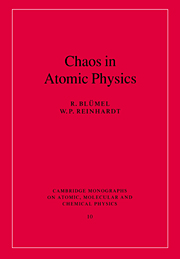Book contents
- Frontmatter
- Contents
- Preface
- 1 Introduction
- 2 Chaos: tools and concepts
- 3 Chaos in classical mechanics
- 4 Chaos in quantum mechanics
- 5 The kicked rotor: paradigm of chaos
- 6 Microwave-driven surface state electrons
- 7 The hydrogen atom in a strong microwave field
- 8 The kicked hydrogen atom
- 9 Chaotic scattering with CsI molecules
- 10 The helium atom
- 11 Chaos in atomic physics: state of the art and research directions
- References
- Index
9 - Chaotic scattering with CsI molecules
Published online by Cambridge University Press: 14 September 2009
- Frontmatter
- Contents
- Preface
- 1 Introduction
- 2 Chaos: tools and concepts
- 3 Chaos in classical mechanics
- 4 Chaos in quantum mechanics
- 5 The kicked rotor: paradigm of chaos
- 6 Microwave-driven surface state electrons
- 7 The hydrogen atom in a strong microwave field
- 8 The kicked hydrogen atom
- 9 Chaotic scattering with CsI molecules
- 10 The helium atom
- 11 Chaos in atomic physics: state of the art and research directions
- References
- Index
Summary
In all of the atomic and molecular systems studied in the previous chapters the relevant dynamics was the bound-space dynamics with the continuum playing either no role at all (see, e.g., the kicked rotor and the driven CsI molecule), or only an auxiliary role for probing the bound-space dynamics with the help of the observed ionization signal (see, e.g., the driven surface state electrons and microwave-driven hydrogen atoms). In this chapter we focus on atomic and molecular scattering, i.e. on processes in which the continuum plays an essential role. This subject has recently attracted much attention as dynamical instabilities and chaos have been discovered in the simplest scattering systems. Complicated scattering in an atomic physics system was noticed as early as 1971 by Rankin and Miller in the theoretical description of a simple chemical reaction. In 1983 Gutzwiller observed complicated behaviour of the quantum phase shift in a schematic model of chaotic scattering. 1986 saw the publication of various important papers on chaotic scattering. Eckhardt and Jung (1986) reported on the occurrence of chaos in a model scattering system. Chaos was found by Davis and Gray (1986) in the classical dynamics of unimolecular reactions, and Noid et al. (1986) noticed fractal behaviour in the He – I2 scattering system. These papers were an important catalyst for the creation of a whole new field: chaotic scattering.
- Type
- Chapter
- Information
- Chaos in Atomic Physics , pp. 216 - 239Publisher: Cambridge University PressPrint publication year: 1997

